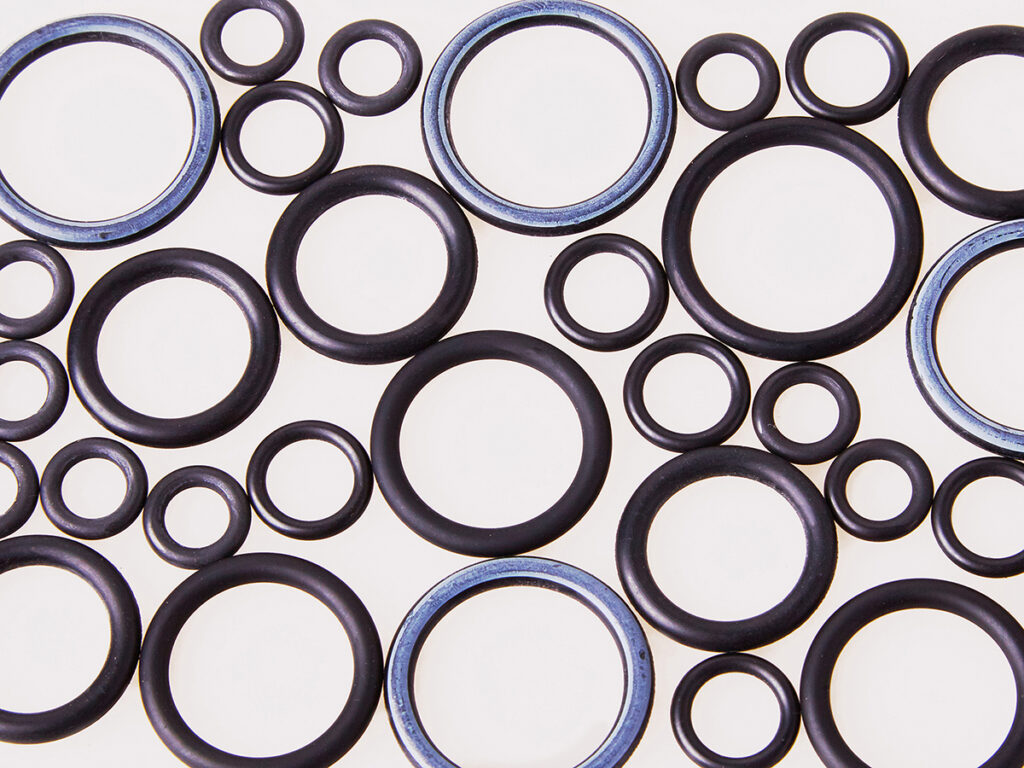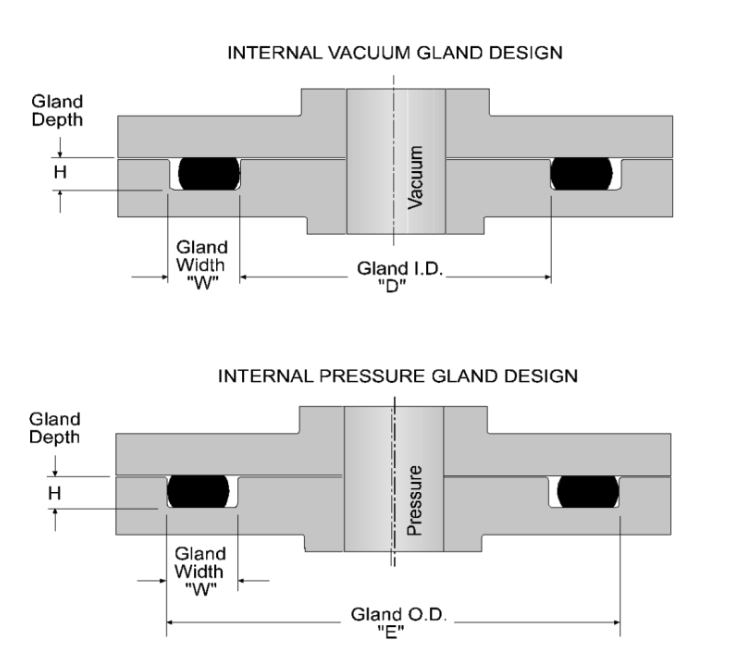5 Steps To Choose The Right O-Ring

O-rings are robust sealing solutions for nearly endless applications in every industry. They will only work well, though, if you choose the right o-ring from the start. If you use the wrong material, profile, or size, your o-ring’s integrity will inevitably suffer and, ultimately, fail.
The good news is that you have the resources to make the right choice for your team right here. There are essentially five steps to choose the correct o-ring for your application. Barring unique application challenges, you should have the information to make the right decision for your seal after reading through these resources.
If you have any questions or unique considerations, our team is happy to help you find a solution quickly.
To determine if that step is necessary, let’s walk through the five steps to choosing the right o-ring for your application.
1. Identify Your Application’s Challenges
Before you can do anything else, you need to identify exactly what challenges your o-ring will face. We consider the following:
- Chemical exposure
- Ozone exposure
- Operating high temperatures
- Operating low temperatures
- High pressure
- Rapid decompression
- Static application
- Dynamic application
- Weather exposure
- Steam or hot amines
You should also be aware of any regulatory requirements of your application, such as USDA 3A, USP CL VI, or FDA CFR 21.
Once you have the list of challenges your application will face and relevant regulations, you can get into the meat of choosing your o-ring.
2. Choose Your O-Ring’s Material(s)
One of the most important parts of choosing an o-ring is identifying the right material. A few popular options include FFKM, PTFE, EPDM, and NBR.
FFKM
FFKM overcomes:
- Chemical exposure
- Ozone exposure
- Operating high temperatures
- Operating low temperatures
- High pressure
- Rapid decompression
- Static application
- Dynamic application
- Weather exposure
- Steam or hot amines
FFKM is best suited for high- or low-operating temperature applications and applications with aggressive solvents, chemicals, or media that would cause other materials to fail. It is used in almost every industry, particularly oil and gas, medical and pharmaceutical applications, and semiconductors.
PTFE
PTFE overcomes:
- Chemical exposure
- Ozone exposure
- Operating high temperatures
- Operating low temperatures
- Rapid decompression
- Static application
- Weather exposure
- Steam or hot amines
PTFE is best suited for applications that do not need a high compression set but also excellent chemical and temperature resistance. These include medical devices, coatings, and pest control. It also works well in ultra-low temperatures, like aerospace and automotive manufacturing.
EPDM
EPDM overcomes:
- Ozone exposure
- Operating high temperatures
- Operating low temperatures
- High pressure
- Rapid decompression
- Static application
- Dynamic application
- Weather exposure
- Steam or hot amines
EPDM is best suited for weatherproofing because it can withstand extreme elements. It is frequently found in roofing, windows, doors, cell towers, and other outdoor applications. It also works well with applications that use steam, automotive brake fluid, vibration dampeners, and isolators.
NBR
NBR overcomes:
- Chemical exposure
- Operating low temperatures
- High pressure
- Rapid decompression
- Static application
- Dynamic application
NBR is universally used in basic sealing applications because it is low-cost and offers comprehensive benefits and physical properties. We see it often in automotive, water treatment and filtration, and pool and spa applications.
NBR can be formulated to excel in harsh environments, including aerospace and other low-temperature applications.
Curious About Chemical Compatibility?
Use our comprehensive chemical compatibility guide to ensure the material that best meets your needs will also be compatible with the chemicals you use. The guide also includes a cost gauge to help you choose an option in your budget early on.
3. Choose Your O-Ring’s Profile
There are a few common profiles for an o-ring, but there are numerous solutions for a variety of challenges your seal might face. This knowledge is important, but we always have experts ready to help you choose the right material, profile, and size for your seal to ensure success.
With that being said, let’s lay out some profile basics!
O-Ring
First and foremost, there is the tried and true o-ring. O-rings are incredibly versatile and offer a wide range of solutions for almost any application and industry. These sealing solutions can also be paired with complementary fittings that help them function better in your application.
Pros
- O-rings are incredibly versatile. They are very customizable and come in various materials, colors, sizes, etc.
- They are one of the most common sealing solutions, making them readily available in a range of standard sizes, materials, and customization options.
- Because they are so widely available, o-rings are often cost-effective.
- If you are using o-rings in large quantities, you can purchase o-ring cord, which can be used to splice and vulcanize custom o-rings on-site.
Cons
- O-rings can sometimes be problematic in dynamic applications (twisting, rolling, etc.).
- They have limited high-pressure resistance. Thus, backup rings may be needed depending on your application pressure conditions.
While o-rings are often a solution, they might not be the best solution for your application.
X-Ring (or Quad-Rings®)
X-rings (or quad-rings®) are similar to o-rings, but their cross-section forms an X with four contact points. These are an alternative to o-rings and are recommended for low-speed reciprocating or oscillatory motions that are twisting, rolling, or bunching.
Pros
- X-rings provide less friction than o-rings.
- They offer four points of contact when sealing.
- They are interchangeable with o-ring sizes and gland designs, making them an easy substitute.
- These o-ring alternatives are available in the same standard sizes and custom sizes as o-rings, while being readily available in USA AS568 standard sized NBR Buna-N and FKM.
Cons
- X-rings are not recommended for pressures >500 psi.
- As they are more specialized, x-rings may not be available in all compounds.
- They are also a little more expensive than standard o-rings.
U-Cup Lip Seals
U-cup lip seals are in the same general shape as an o-ring, but the cross-section is a U. U-cups can function independently, but they also have the unique option of being “loaded.” A loaded u-cup has an o-ring or spring energizer nestled into its internal groove.
U-cups are designed for dynamic reciprocating applications up to 1250 PSI, but loaded u-cups can handle up to 5,000 PSI.
Pros
- U-cups have longer sealing life than o-rings because they experience lower levels of friction.
- These seals are also available in nonsymmetrical rod and piston configurations, which are common applications for u-cup seals.
- Polypaks® use an o-ring to provide sealing force at a low pressure.
- We can design custom lip seals for existing grooves that are not standard.
Cons
- Unfortunately, u-cups are more difficult to size than o- or x-rings.
- They are available in a limited array of materials and standard sizes.
- U-cup seals are a more expensive solution than other options.
Glyd Rings®
Glyd Rings® combine the power of a Turcon-based slipper seal with an energizing o-ring to extend the life of an o-ring in dynamic, reciprocating applications. They use an interference fit that couples with the extra tightness of the o-ring to ensure a quality seal at lower pressure.
Pros
- Glyd Rings® are typically suitable for slow and fast reciprocating speeds running dry or lubricated.
- They can withstand pressures up to 3000 PSI in most applications.
- They operate at low friction with no stick-slip effect.
- Glyd Rings® are compatible with all o-ring materials.
- With a high wear resistance, they also offer minimal break-out force.
Cons
- Glyd Rings® cannot be stretched more than 5% during installation.
- They are not recommended for oscillating applications.
4. Size Your O-Ring
Sizing is by far the trickiest but most important part of choosing an o-ring. When we diagnose failed seals, an improperly sized o-ring is often the culprit.
To start, review gland design basics. Then, you will need to determine the way pressure works in your gland. Your operation will be one of the following:
- Internal Pressure
- Internal Vacuum
- Dynamic Rod and Piston
- Static Rod and Piston

Now, to determine your sizing, you will want to know the following gland measurements:
For Internal pressure:
- Inner Diameter
- Depth
- Width
For Internal Vacuum:
- Outer Diameter
- Depth
- Width
For Dynamic Rod and Piston:
- Outer Diameter Sealing Width
- D Diameter
- E Diameter
- F Diameter
- Inner Diameter Sealing Width
- II Diameter
- I Diameter
- G Diameter
For Static Rod and Piston:
- Outer Diameter Sealing Width
- D Diameter
- H Gap
- E Bore Diameter
- Inner Diameter Sealing Width
- H Gap
- G Tube Diameter
- F Gland Diameter
Now that you have your important measurements, you can use a comprehensive sizing chart to select the correct sized o-ring. The following links will take you to the corresponding sizing chart for your appropriate region:
Common Metric O-Ring Sizing Chart
Japanese JIS O-Rings Sizing Chart
British BS O-Ring Sizing Chart
5. Choose Your Supplier
Last but certainly not least, you will need to choose your supplier. Your supplier should be your collaborative partner in consolidating and streamlining your sealing needs. To help you identify the exact questions you should be asking suppliers, we’ve included a comprehensive list in our Complete Guide To Choosing An O-Ring.
